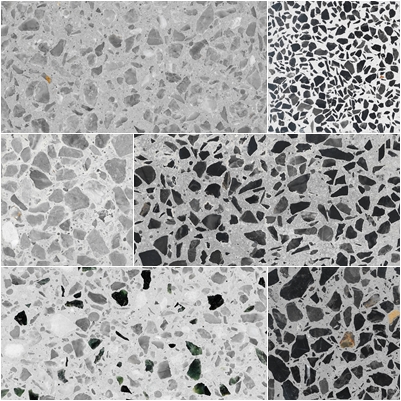The Evolution of Terrazzo – A Timeline
Terrazzo these days has become synonymous to subtle elegance, proven durability and unparalleled customizability. Add to that, terrazzo is the most affordable flooring system based on its life cycle and the materials needed to manufacture it. Terrazzo in fact, is so popular that quite a number of designers, builders and architects recommend it to a lot of their clientele – from residential spaces to massive shopping malls and hotels. Indeed, it has definitely come a long way since its humble beginnings as recycled discarded marble remnants.
Mid-16th Century
Ingenious Venetian stone and mosaic workers discovered that the marble remnants they have been discarding can be reused as building materials for terraces that they built around their homes. Over the years, the technique to leveling the odd-sized chips progressed from manually rubbing the uneven surface with stone, to the development of the galero – a long-handled, weighted grinding stone. When workers noticed that goat’s milk brought out the opulent colors and natural luster of the marble, it became the first known sealer.
During this time, the terrazzo and marble industry was mostly monopolized by north region’s Frulili craftsmen. To this day, the industry is still predominantly held by the latter generations of those talented craftsmen.
1890 – 1915
Terrazzo was first laid in the United States of America by Italian craftsmen in 1890; the location – the famous Vanderbilt residence on Fifth Avenue in New York. However, during that time, mosaics were still largely favored over terrazzo. The massive migration of Italians to the US from 1900 to 1915, established the Italian craftsmen as the aristocracy of the immigrant labor force because their work was so highly skilled and valued. They were given the name, terazzeri and were often regarded as true artists. These honors bestowed on them made them guard the secrets of their craft with much zeal and fervor – only handing them down from father to son with each passing generation.
1920s
After World War 1, terrazzo became the flooring of choice, passing over and replacing marble mosaics. This is because architects in the 20s recognized that terrazzo had a greater potential design flexibility which is perfect for the smooth and curvilinear style of Art Deco that was starting to gain popularity. Additionally, the electric grinder was invented in 1924 and brought with it the ability to gain a finer finish, quicker and more accurate production at significantly lowered costs.
Some of the more popular structures that were built with terrazzo include Radio City Music Hall and the Solomon R. Guggenheim Museum, famously designed by Frank Lloyd-Wright. These buildings attest to the durability, timelessness and elegance of terrazzo.
Current time
To this day, terrazzo has held its own against most of the other flooring systems in the market today. And with the advent of new technology, Terrazzo has also become a major material in other structures such as 3D wall installations, outdoor furniture and many more.


Pingback: Top 5 Washroom Tile Trends You Need To Know About - DAILY BELY
Pingback: Top 5 Washroom Tile Trends You Need To Know About
emil